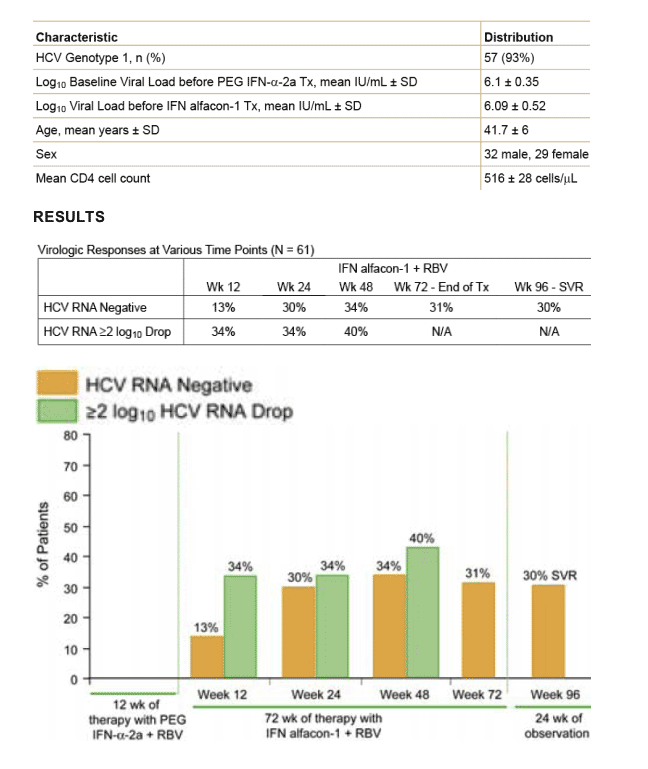 |
 |
 |
| |
Consensus Interferon + Ribavirin SVRs in Coinfected
|
| |
| |
Reported by Jules Levin
AASLD, Nov 2005, San Francisco
"Sustained Virologic Response to Re-treatment with IFN alfacon-1 + Ribavirin in HCV/HIV–Co-infected Patients Who Had Failed 12 Weeks of Pegylated Interferon alfa-2a plus Ribavirin Therapy"
Carroll Leevy1, Chris Chalmers2, Lawrence M. Blatt2
1The New Jersey School of Dentistry and Medicine, Newark, NJ
2InterMune, Inc., Brisbane, CA
Objective
We recently reported that IFN alfacon-1 + RBV re-treatment resulted in an SVR of 37% in mono-infected chronic hepatitis C patients who failed therapy with PEG IFN-_-2a + RBV. The objective of this analysis was to evaluate the effect of re-treating, with IFN alfacon-1 + RBV, HCV/HIV– co-infected patients who failed to achieve a ≥2 log10 reduction in HCV RNA after 12 weeks of PEG IFN-_-2a + RBV.
Hypothesis for Treatment Paradigm
Since all HCV responsiveness to IFN-_ is mediated by host gene induction, patients who fail to respond to standard treatment with PEG IFN-_-2a + RBV may benefi t from use of a bio-optimized, non-naturally occurring IFN-_ (IFN alfacon-1) that has been demonstrated to hyperstimulate the production of interferon-stimulated genes.
IFN alfacon-1: Bio-optimized Type I Interferon
IFN alfacon-1 is a novel, non-naturally occurring type I consensus interferon. The 166-amino acid sequence of interferon alfacon-1 was derived by scanning the sequences of several nonallelic natural IFN-_ subtypes and assigning the
most frequently observed amino acid in each corresponding position, producing a consensus sequence.
Comparison of Specifi c Antiviral Activity (units/mg) Using Vesicular Stomatitis Virus
IFN alfacon-1 can be effective in treating HCV patients who do not respond to monotherapy. Specific activity of IFN alfacon-1 is up to 3 log10 greater than that of PEG-IFN.

Inclusion Criteria
- Patients were co-infected with HIV and HCV
- Patients were stable on HAART therapy (CD4 cell count >400)
- Patients had 12 weeks of PEG IFN-_-2a 180 _g SC weekly + RBV 1,000–1,200 mg
per day (≦75 kg = 1,000 mg, >75 kg = 1,200 mg) and did not have ≥2 log10 drop in HCV RNA
- Patients tolerated the previous 12 weeks of PEG IFN-_-2a + RBV therapy well
ABSTRACT
Background: Patients who are co-infected with hepatitis C virus (HCV) and HIV are at signifi cant risk for progression to Liver fibrosis, cirrhosis, and hepatocellular carcinoma; thus, HCV viral eradication is an essential goal of therapy. Sustained virologic response (SVR) rates in treatment-naïve HCV/HIV–co-infected patients treated with pegylated interferon alfa-2a (PEG IFN-_-2a) + ribavirin (RBV) are ~40%. We recently reported that IFN alfacon-1 + RBV re-treatment resulted in an SVR of 37% in mono-infected chronic hepatitis C patients who failed therapy with PEG IFN-_-2a + RBV. We now report retreatment of HCV/HIV–co-infected patients with IFN alfacon-1 + RBV who failed to achieve a ≥2 log10 reduction in HCV RNA after 12 wk of PEG IFN-_-2a + RBV.
Methods: All patients (N = 61) received PEG IFN-_-2a + RBV for 12 wk and did not achieve ≥2 log10 drop in HCV RNA. With no washout period, patients were re-treated with IFN alfacon-1, 15 _g subcutaneous (SC) daily, and weight-based RBV for 72 wk. Patients were assessed at Wk 96 for SVR. 57 (93%) patients had HCV genotype 1; mean baseline viral load was 6.1 ± 0.35 log10 IU/mL; and 32 (53%) patients were African American. Mean baseline CD4 cell counts were 516 ± 28 cell/_L.
A total of 61 patients were treated with IFN alfacon-1 + RBV after failing to respond to 12 weeks of treatment with PEG IFN alfa-2a.

The low relapse rate in this retrospective analysis—end of therapy 31% and SVR 30%—may be due to the extended duration of treatment (i.e., 72 wk).
Flu-like symptoms were the most commonly reported adverse effect. Hematological toxicity required the use of epoetin alfa in 32 (53%) patients and fi lgrastim in 27 (44%) patients. 10 patients (16%) required both epoetin alfa and
filgrastim. No patient withdrew from therapy.
Conclusions: These results suggest that a significant number of HCV/HIV–co-infected patients who have failed treatment with PEG IFN-_-2a + RBV can achieve an SVR when re-treated with IFN alfacon-1,15 _g SC daily, and weight-based RBV for 72 wk. Further study is warranted to confirm these initial observations.
SAFETY
Flu-like symptoms were the most commonly reported adverse effect. Hematological toxicity required the use of epoetin alfa in 32 (53%) patients and fi lgrastim in 27 (44%) patients. Ten patients (16%) required both epoetin alfa and filgrastim. No patient withdrew from therapy.
|
|
| |
| |
|
 |
 |
|
|